
Ossian is the narrator and purported author of a cycle of epic poems published by the Scottish poet James Macpherson, originally as Fingal (1761) and Temora (1763), and later combined under the title The Poems of Ossian. Macpherson claimed to have collected word-of-mouth material in Scottish Gaelic, said to be from ancient sources, and that the work was his translation of that material. Ossian is based on Oisín, son of Fionn mac Cumhaill, a legendary bard in Irish mythology. Contemporary critics were divided in their view of the work's authenticity, but the current consensus is that Macpherson largely composed the poems himself, drawing in part on traditional Gaelic poetry he had collected.
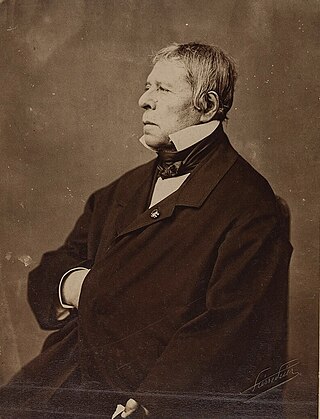
Jean-Auguste-Dominique Ingres was a French Neoclassical painter. Ingres was profoundly influenced by past artistic traditions and aspired to become the guardian of academic orthodoxy against the ascendant Romantic style. Although he considered himself a painter of history in the tradition of Nicolas Poussin and Jacques-Louis David, it is his portraits, both painted and drawn, that are recognized as his greatest legacy. His expressive distortions of form and space made him an important precursor of modern art, influencing Picasso, Matisse and other modernists.
Malvina is a feminine given name derived from the Scottish Gaelic Mala-mhìn, meaning "smooth brow". It was popularized by the 18th century Scottish poet James Macpherson. Other names popularised by Macpherson became popular in Scandinavia on account of Napoleon, an admirer of Macpherson's Ossianic poetry, who was the godfather of several children of Jean Baptiste Jules Bernadotte, an officer of his who ruled Norway and Sweden in the early 19th century.
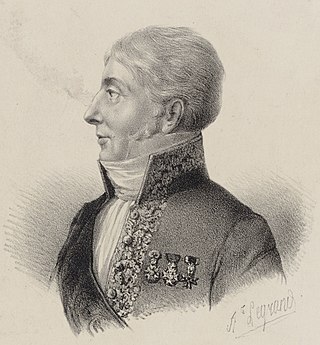
Jean-François Le Sueur was a French composer, best known for his oratorios and operas.

The Musée Ingres Bourdelle is located in Montauban, France. It houses a collection of artworks and artifacts related to two famous artists natives of that town, painter Jean Auguste Dominique Ingres and sculptor Antoine Bourdelle, as well as their own collections and other works of art.

Ossian, ou Les bardes is an opera in five acts by the French composer Jean-François Le Sueur. The libretto, by Alphonse François "Paul" Palat-Dercy and Jacques-Marie Deschamps, is based on the Ossian poems of James Macpherson, which had been translated into French by Pierre-Prime-Félicien Le Tourneur.

Uthal is an opéra comique in one act by the French composer Étienne Méhul. The libretto, by Jacques-Benjamin-Maximilien Bins de Saint-Victor is based on the Ossian poems of James Macpherson. It was first performed at the Opéra-Comique in Paris on 17 May 1806. Méhul tried to give the work a dark "Scottish" atmosphere by eliminating the violins from the orchestra and replacing them with violas.
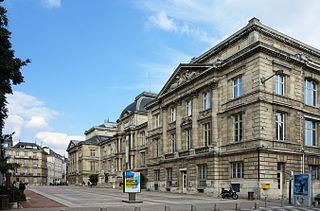
The Musée des Beaux-Arts de Rouen is an art museum in Rouen, in Normandy in north-western France. It was established by Napoléon Bonaparte in 1801, and is housed in a building designed by Louis Sauvageot and built between 1877, and 1888. Its collections include paintings, sculptures, drawings and objets d'art.

Portrait of Monsieur Bertin is an 1832 oil on canvas painting by Jean-Auguste-Dominique Ingres. It depicts Louis-François Bertin (1766–1841), the French writer, art collector and director of the pro-royalist Journal des débats. Ingres completed the portrait during his first period of success; having achieved acclaim as a history painter, he accepted portrait commissions with reluctance, regarding them as a distraction from more important work. Bertin was a friend and a politically active member of the French upper-middle class. Ingres presents him as a personification of the commercially minded leaders of the liberal reign of Louis Philippe I. He is physically imposing and self-assured, but his real-life personality shines through – warm, wry and engaging to those who had earned his trust.
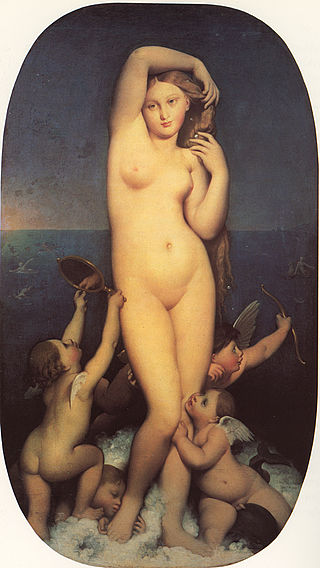
Venus Anadyomene is a painting by the French painter Jean-Auguste-Dominique Ingres. It is now held at the Musée Condé, Chantilly, France. It is a female nude of the Venus Anadyomene type, showing the goddess Venus rising from the sea.

Don Pedro of Toledo Kissing Henry IV's Sword was originally a painting of 1814 in the Troubador style by the French artist Jean-Auguste-Dominique Ingres, showing the Spanish ambassador Pedro Álvarez de Toledo, 5th Marquis of Villafranca kissing the sword of Henry IV of France in the salle des Caryatides of the Louvre Palace. The 1814 painting is now lost. Between 1819 and 1832, Ingres painted three additional versions of the subject.

The Martyrdom of Saint Symphorian is an 1834 painting by the French artist Jean-Auguste-Dominique Ingres. It shows the death of Saint Symphorian, the first Christian martyr in Gaul. Painted in oil on canvas and measuring 407 x 339 cm, it is now in Autun Cathedral. Although Ingres considered the painting—completed only after ten years of diligent work—one of his crowning achievements, it was criticized harshly when he exhibited it in the Paris Salon of 1834. It subsequently has been considered emblematic of Ingres' misguided ambition to excel as a history painter.

Roger Freeing Angelica or Ruggiero Freeing Angelica is an 1819 painting by the French artist Jean-Auguste-Dominique Ingres, inspired by Orlando Furioso by Ariosto. An oil painting on canvas measuring 147 x 199 cm, it is owned by the Louvre. Ingres subsequently painted several variants of the composition.

Romulus' Victory Over Acron is a painting completed in 1812 by the French Neoclassical artist Jean-Auguste-Dominique Ingres. Ingres' source for this subject comes from Plutarch's Life of Romulus. The painting depicts the war that resulted from the Roman abduction of the young Sabine women in an effort to remedy the shortage of women in the newly founded city of Rome. In retaliation Acron, the king of the neighbouring tribe, the Caeninenses, declared war upon the Romans. He and his tribesmen were mercilessly defeated and their city sacked by the Romans.
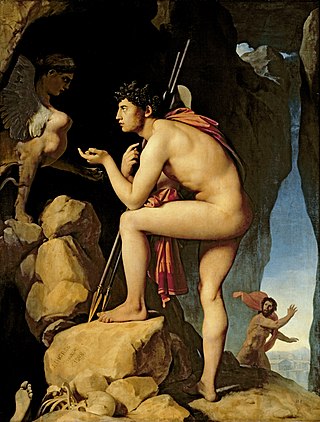
Oedipus and the Sphinx is a painting by the French Neoclassical artist Jean-Auguste-Dominique Ingres. Originally a student work painted in 1808, it was enlarged and completed in 1827. The painting depicts Oedipus explaining the riddle of the Sphinx. An oil painting on canvas, it measures 189 x 144 cm, and is in the Louvre, which acquired it in 1878.
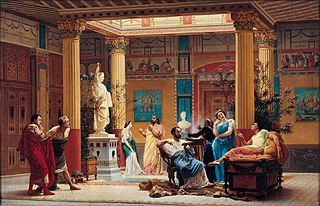
Répétition du "Joueur de flûte" et de "La femme de Diomède" chez le prince Napoléon is a painting by French artist Gustave Boulanger. The painting's full title as given in the catalogue for the Paris Salon of 1861 is Répétition du "Joueur de flûte" et de "la Femme de Diomède," chez S.A.I. le prince Napoléon, dans l’atrium de sa maison, avenue Montaigne.

Virgil reading the Aeneid before Augustus, Livia and Octavia, known in French as Tu Marcellus Eris, is an 1812 painting by Jean-Auguste-Dominique Ingres. It is an oil on canvas measuring 304 x 323 cm and is in the Musée des Augustins in Toulouse. It depicts the moment when Virgil, reciting his work to the Emperor Augustus, his wife Livia and his sister Octavia, mentions the name of Octavia's dead son, Marcellus, causing Octavia to faint. Augustus' advisors, Marcus Agrippa and Gaius Maecenas, can be seen watching in the background. The painting is based on an anecdote, recorded in the late fourth-century vita of Virgil by Aelius Donatus, in which the poet read the passage in Book VI in praise of Octavia's late son Marcellus, and Octavia fainted with grief. This anecdote has also been depicted in works by other artists, including Jean-Joseph Taillasson, Antonio Zucchi, Jean-Baptiste Wicar, Jean-Bruno Gassies and Angelica Kaufmann.

Culmin's Ghost Appears to his Mother is an oil on canvas painting of 1794 by the Danish neoclassical artist Nicolai Abildgaard. It depicts a scene from the Ossian poetry cycle.

Christian Gottlieb Kratzenstein Stub, also written Kratzenstein-Stub, was a Danish painter, mainly of mythological subjects which were popular in Denmark at the time.
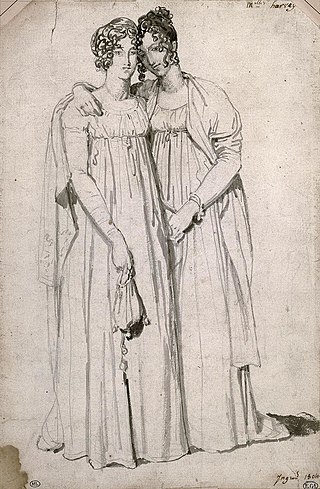
Elizabeth or Elisabeth Harvey was an English artist known for Malvina Lamenting the Death of Oscar and for portraits of Jacques-Henri Bernardine de Saint-Pierre and his family.





















